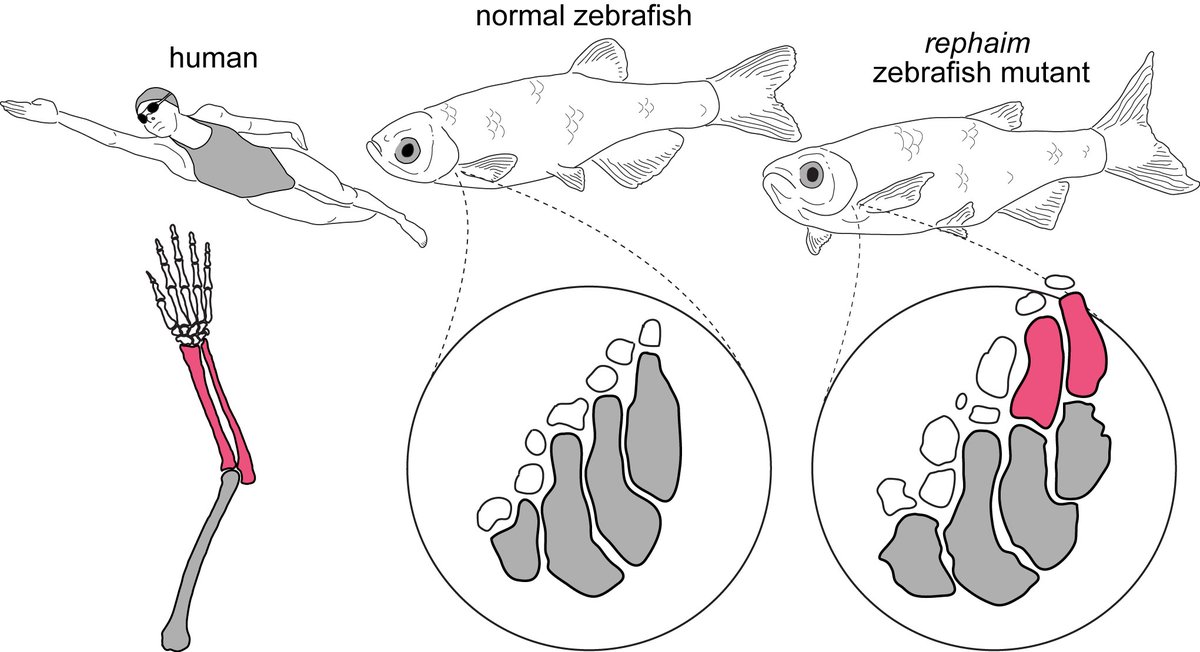Can a fin (still) become a limb?
To find out, @fishyskeleton, @khenke2012, and I performed genetic studies in the zebrafish & found the remarkable hidden ability of fins to become more limb-like. Look below for a quick summary of our findings!
https://authors.elsevier.com/c/1cX5dL7PXez5d
To find out, @fishyskeleton, @khenke2012, and I performed genetic studies in the zebrafish & found the remarkable hidden ability of fins to become more limb-like. Look below for a quick summary of our findings!
https://authors.elsevier.com/c/1cX5dL7PXez5d
Fins and limbs have very different skeletal patterns. Limbs are complex, while fins are simple. Teleost fishes have especially simple fins & have no distally articulating bones. This is despite both descending from a common ancestral fin in the ancestor.
To investigate the genetic basis of these differences, we used a forward genetics approach to find zebrafish mutants that break the simple teleost mold. And we found them! The rephaim mutant makes a fin with new bones in the middle of the fin.
Like distal limb bones, these new bones do not articulate with the shoulder directly. Unexpectedly, the mutant bones are well-form and are integrated into the fin. They make joints with their neighboring bones and are even attached to the fin musculature.
We tracked when these bones appear in development and found that they arise through the splitting of an initially connected condensation. This splitting process is similar to how the bones are segmented in the limb.
We determined that these mutant limb-like bones arise due to mutations in the waslb and vav2 genes. This was surprising because these genes were not known to play a role in patterning the skeleton.
Moreover, we found that vav2 and waslb act together in a pathway. One function of Wasl genes is to promote the formation of F-actin, a component of the cytoskeleton. We found that Wasl mutants exhibit defects in F-actin formation in the fin.
The distribution of F-actin in the fin was interesting, lots of little dots all through the fin fold. We discovered that these dots are located where the support fibers of the fin fold interact with migratory cells that express hox genes.
While vav2 & waslb are unknown in the skeleton patterning world, the hox genes are preeminent. We asked if our mutations change hox activity to make the new bones. We did this by creating fish that glow red where the hoxa11b gene is activated.
Hox genes are amazing! Some of them pattern the shoulder-to-finger axis of the arm. The Hox13 genes are required to make the wrist and hand, and the Hox11 genes are required to make the forearm. In fish, Hox13 is also needed to make the distal fin rays.
We found that our mutants caused a dramatic increase in Hox11 expression over time when compared to wild type siblings. When we used CRISPR to remove the Hox11 genes from our mutants, and found that this prevented the new bones from forming. The bones need Hox11 to form.
In limbs, HoxA13 suppresses the activity of HoxA11. We removed the Hox13 genes from our mutants, and were shocked to find this resulted in an even more complex fin skeleton! This suggests HoxA13 works against HoxA11 in fins as well as limbs.
Our mutants reveal a latent ability in fins to undergo limb-like transformations using a Hox code. This suggests that such a patterning mechanism was present in the ancestor of bony fishes & retained in a hidden in teleosts for 100s of millions of years.
This raises questions about the latent potential lurking in each genome, waiting to be activated. If a fish can do this, what can humans do in the realms of regeneration and health span?
Finally, could vav2/waslb have played a role in the historical fin-to-limb transition? Possibly! We found that Wasl is required for normal limb development in the mouse, and loss of Wasl caused the loss of distal bones.
How the vav2/waslb pathway interacts with other genes to achieve proper patterning of the body is a big big big question, and a little teleost fish has given us a fin the doorway.
Thanks for reading! And thank you to @greerwig and @HarvardOEB for helping us spread the word!
Of course, this work would not have been possible without the expert guidance of @pinaleno and the help of the excellent animal care team at @BostonChildrens

 Read on Twitter
Read on Twitter























